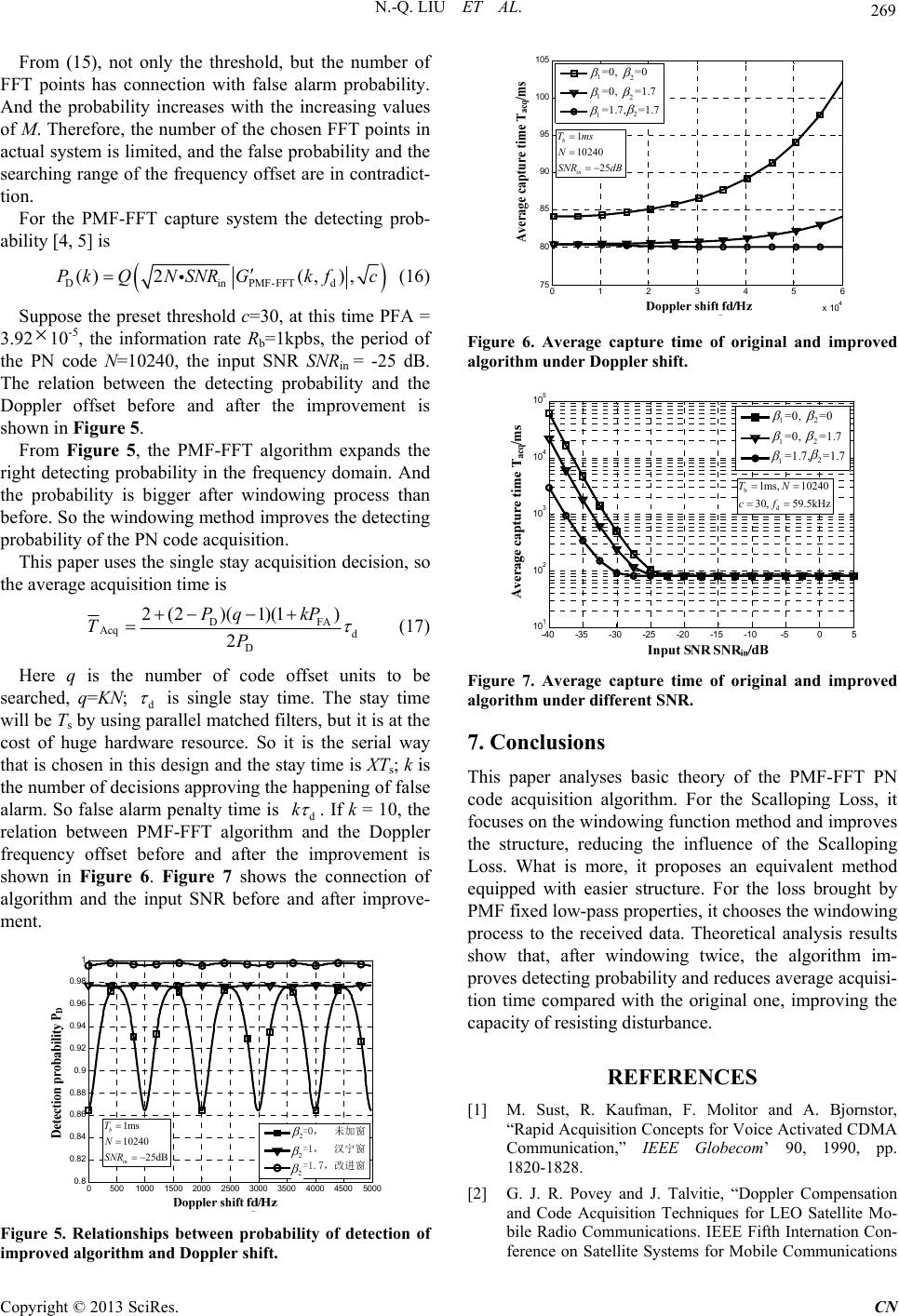
N.-Q. LIU ET AL. 269
From (15), not only the threshold, but the number of
FFT points has connection with false alarm probability.
And the probability increases with the increasing values
of M. Therefore, the number of the chosen FFT points in
actual system is limited, and the false probability and the
searching range of the frequency offset are in contradict-
tion.
For the PMF-FFT capture system the detecting prob-
ability [4, 5] is
DinPMF-FFT
()2(, ),Pk QNSNRGkfc
d
(16)
Suppose the preset threshold c=30, at this time PFA =
3.9210-5, the information rate Rb=1kpbs, the period of
the PN code N=10240, the input SNR SNRin = -25 dB.
The relation between the detecting probability and the
Doppler offset before and after the improvement is
shown in Figure 5.
From Figure 5, the PMF-FFT algorithm expands the
right detecting probability in the frequency domain. And
the probability is bigger after windowing process than
before. So the windowing method improves the detecting
probability of the PN code acquisition.
This paper uses the single stay acquisition decision, so
the average acquisition time is
D
Acq d
D
2(2)( 1)(1)
2
Pq kP
TP
FA
(17)
Here q is the number of code offset units to be
searched, q=KN; d
is single stay time. The stay time
will be Ts by using parallel matched filters, but it is at the
cost of huge hardware resource. So it is the serial way
that is chosen in this design and the stay time is XTs; k is
the number of decisions approving the happening of false
alarm. So false alarm penalty time is d
k
. If k = 10, the
relation between PMF-FFT algorithm and the Doppler
frequency offset before and after the improvement is
shown in Figure 6. Figure 7 shows the connection of
algorithm and the input SNR before and after improve-
ment.
05001000150020002500 3000 35004000 45005000
0. 8
0. 82
0. 84
0. 86
0. 88
0. 9
0. 92
0. 94
0. 96
0. 98
1
多普勒频偏f
d
/Hz
检测概率P
D
K
2
=0, 未加窗
K
2
=1, 汉宁窗
K
2
=1.7,改进窗
in
1ms
10240
25dB
b
T
N
SNR
2
2
2
Figure 5. Relationships between probability of detection of
improved algorithm and Doppler shift.
0 1 234 56
x 10
4
75
80
85
90
95
100
105
多普勒频偏f
d
/Hz
平均捕获时间T
Acq
/ms
K
1
=0, K
2
=0
K
1
=0, K
2
=1.7
K
1
=1.7,K
2
=1.7
1
10240
25
b
in
Tms
N
SNR dB
1
1
1
2
2
2
Figure 6. Average capture time of original and improved
algorithm under Doppler shift.
-40 -35 -30 -25-20 -15 -10 -5 0 5
10
1
10
2
10
3
10
4
10
5
输入信噪比SNR
/dB
平均捕获时间T
Acq
/ms
K
1
=0, K
2
=0
K
1
=0, K
2
=1.7
K
1
= 1.7,K
2
=1.7
1
1
1
2
2
2
b
d
1ms, 10240
30, 59.5kHz
TN
cf
Figure 7. Average capture time of original and improved
algorithm under different SNR.
7. Conclusions
This paper analyses basic theory of the PMF-FFT PN
code acquisition algorithm. For the Scalloping Loss, it
focuses on the windowing function method and improves
the structure, reducing the influence of the Scalloping
Loss. What is more, it proposes an equivalent method
equipped with easier structure. For the loss brought by
PMF fixed low-pass properties, it chooses the windowing
process to the received data. Theoretical analysis results
show that, after windowing twice, the algorithm im-
proves detecting probability and reduces average acquisi-
tion time compared with the original one, improving the
capacity of resisting disturbance.
REFERENCES
[1] M. Sust, R. Kaufman, F. Molitor and A. Bjornstor,
“Rapid Acquisition Concepts for Voice Activated CDMA
Communication,” IEEE Globecom’ 90, 1990, pp.
1820-1828.
[2] G. J. R. Povey and J. Talvitie, “Doppler Compensation
and Code Acquisition Techniques for LEO Satellite Mo-
bile Radio Communications. IEEE Fifth Internation Con-
ference on Satellite Systems for Mobile Communications
Copyright © 2013 SciRes. CN